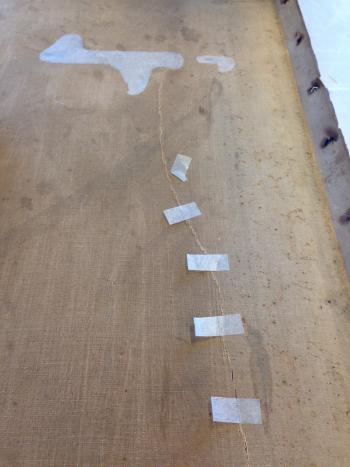 One of our recent projects, these photographic crayon enlargements, associated with founder of the National Zoo William Temple Hornaday, were made on sensitized paper that was then adhered to a linen “canvas” stretched around wooden frames. The paper had become brittle, and handling at some point in the past led to a number of punctures and tears through both the paper and the linen support. Water damage was also evident from visible tide lines, as were various discolored areas. The goal of our treatment was to remove the enlargements from the wooden stretchers, stabilize the damaged areas, and devise a suitable new mounting method.
One of our recent projects, these photographic crayon enlargements, associated with founder of the National Zoo William Temple Hornaday, were made on sensitized paper that was then adhered to a linen “canvas” stretched around wooden frames. The paper had become brittle, and handling at some point in the past led to a number of punctures and tears through both the paper and the linen support. Water damage was also evident from visible tide lines, as were various discolored areas. The goal of our treatment was to remove the enlargements from the wooden stretchers, stabilize the damaged areas, and devise a suitable new mounting method.
The wooden stretchers caused three issues: first, tannins present in the wood had discolored the adjacent linen backing and had potential to migrate into the sensitized paper, further weakening the already brittle paper; second, the nails attaching the linen to the wood were rusted and flaking; third, the frame had trapped a large amount of debris. To remove the stretcher, a Preservation Pencil (a hot air gun, coupled with a ultrasonic humidifier to provide local, low humidification) was used to soften the adhesive holding the paper and linen in place, and the enlargement was gently lifted away from the rear of the frame with a microspatula. Once the edges were accessible, the microspatula was used to carefully free the linen out from behind the rusting nails. Once the linen was freed, the stretcher could be lifted away from the enlargement and discarded. The detritus that had accumulated behind the frame was removed by hand first and followed up with a HEPA-filtered vacuum cleaner.
Temporary bridge mends had been applied to the verso of the enlargements to stabilize the free edges of the tears and losses. These were removed mechanically with a microspatula where adhesion was weaker and softened using the hot air humidifier elsewhere.
A heat-set repair tissue made of medium-weight Japanese tissue coated with Plextol B500 acrylic adhesive was then prepared to mend the enlargements. Plextol was chosen for its good adhesion and excellent flow, which allowed the adhesive to securely grip the somewhat open weave of the linen backing while still offering easy reversibility. Mends were shaped for each tear with a perforating pen and made wide enough to provide support to the enlargement. The mends were then applied using a heated spatula through silicone release paper (preventing sticking or scorching), paying particular attention to the edges.
The enlargements were mounted on backing boards of corrugated E-flute board using a series of Japanese paper strips that would hold the objects lightly taut and provide necessary stability. Mounting strips were prepared by applying Plextol to one edge of a strip of the same medium-weight Japanese paper employed for mending. These were then cut into smaller strips, leaving five-inch-long pieces that were one inch wide, with about 1 square inch of the strip coated in Plextol on one side. These strips were applied to the verso of the enlargements.
 Once all strips were attached, the backing board was put in place and registered. The enlargements were worked on with an elevated clear Plexiglas sheet as support, which enabled viewing of the recto and facilitated centering the backing board on the enlargement. The strips were wrapped around the backing board and fixed in place with cast-out films of Lascaux 498 HV acrylic adhesive, reactivated with the heated spatula. Strips were adhered beginning with the centrally positioned strips on each edge to prevent shifting.
Once all strips were attached, the backing board was put in place and registered. The enlargements were worked on with an elevated clear Plexiglas sheet as support, which enabled viewing of the recto and facilitated centering the backing board on the enlargement. The strips were wrapped around the backing board and fixed in place with cast-out films of Lascaux 498 HV acrylic adhesive, reactivated with the heated spatula. Strips were adhered beginning with the centrally positioned strips on each edge to prevent shifting.
Once the enlargements were mounted, areas of the image where the paper was lifting away from the linen backing were tacked back down using more of the Lascaux films. Detailed maps of the placement of these Lascaux pieces were made so future conservators know precisely where the Lascaux was applied.
Now stable and mounted securely, these historic images can be safely handled and displayed as necessary.
Related Collections
Accession 12-570, National Museum of Natural History (U.S.) Division of Mammals, Specimen Records, c. 1887, Smithsonian Institution Archives
Related Resources
Home Sweet Housing: Creating a Unique Enclosure for a Historic Photograph, The Bigger Picture Blog, Smithsonian Institution Archives
Taxidermist Turned Conservationist: The Man that Saved the Bison, A Castle of Curiosities, Smithsonian Mobile App
Produced by the Smithsonian Institution Archives. For copyright questions, please see the Terms of Use.

Leave a Comment